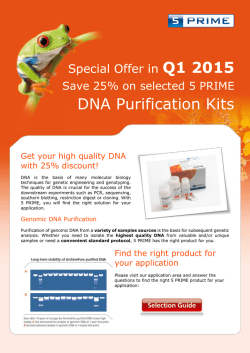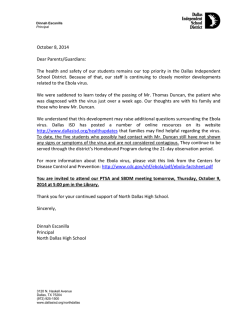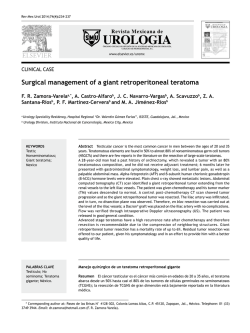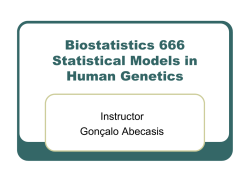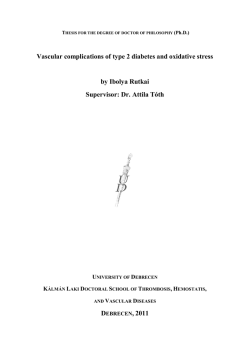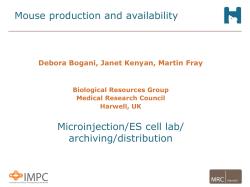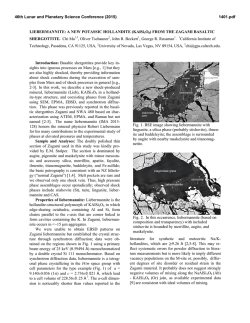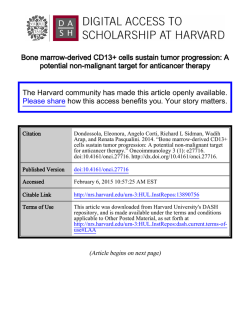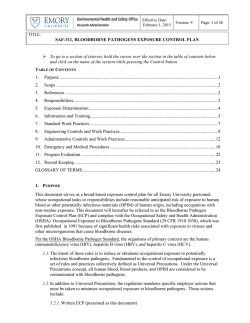
[2-(Hydroxymethyl)-1,3-Oxathiolan-5
ANTIMICROBIAL AGENTS AND CHEMOTHERAPY, Mar. 1994, p. 616-619 Vol. 38, No. 3 0066-4804/94/$04.00+0 Copyright X 1994, American Society for Microbiology Evaluation of the Potent Anti-Hepatitis B Virus Agent (-) cis-5-Fluoro-1- [2- (Hydroxymethyl)-1,3-Oxathiolan-5-yl] Cytosine in a Novel In Vivo Model LYNN D. CONDREAY,l* ROBERT W. JANSEN,1 THOMAS F. POWDRILL,1 LANCE C. JOHNSON,1 DEAN W. SELLESETH,2 MELANIE T. PAFF,1 SUSAN M. DALUGE,3 GEORGE R. PAINTER,2 PHILLIP A. FURMAN,2 M. NIXON ELLIS,2 AND DEVRON R. AVERETT1 Divisions of Experimental Therapy, 1 Virology,2 and Organic Chemistry,3 Wellcome Research Laboratories, Research Triangle Park, North Carolina 27709 Received 6 July 1993/Returned for modification 30 August 1993/Accepted 4 January 1994 A murine model was developed to investigate the in vivo activity of anti-hepatitis B virus (HBV) agents. Mice with subcutaneous tumors of HBV-producing 2.2.15 cells showed reductions in levels of HBV in serum and in intracellular levels of HBV when the mice were orally dosed with (-) cis-5-fluoro-1-[2-(hydroxymethyl)-1,3oxathiolan-5-yl]cytosine (FEC). No effects on tumor size or alpha-fetoprotein levels were observed. FIC can selectively inhibit HBV replication at nontoxic doses. The majority of in vivo studies of potential anti-hepatitis B virus (HBV) agents have been performed with Pekin ducks infected with duck HBV (7, 12-14, 21, 24), although systems using Beechey ground squirrels and woodchucks infected with ground squirrel and woodchuck hepatitis viruses, respectively, have been developed (16, 23). These systems vary with respect to the involvement of the immune component in the disease. All of these models involve relatively large animals which require substantial quantities of compound for evaluation and are difficult to manage in most laboratories. Also, testing of antiviral agents such as nucleoside analogs could generate aberrant results as a consequence of virus-specific differential susceptibility of the viral polymerase. Nagahata et al. developed a transgenic mouse model expressing HBV which addresses the issues of size and HBV polymerase (15). However, anabolism of nucleoside analogs can differ between human and murine cells. Thus, inhibition of HBV replication could differ between human and murine systems for a given nucleoside analog. We sought to develop a small animal system which provides assessment of anti-HBV selectivity in cells originating from human liver. The human hepatoma 2.2.15 cell line is often used for in vitro analysis of potential anti-HBV compounds (3, 5, 9, 11, 17, 18). This cell line has integrated HBV genomic sequences, contains all viral DNA replicative intermediates, produces infectious virus (6, 19, 20), and was derived from the wellcharacterized Hep-G2 cell line (2, 4, 8, 10, 22). To characterize the tumorigenicity of 2.2.15 cells in NIH bg-nu-xid mice, 2.2.15 cells (cultured as described by Jansen et al. [9]) were resuspended in RPMI 1640 buffered with 25 mM HEPES (N-2hydroxyethylpiperazine-N'-2-ethanesulfonic acid) at densities of 1.1 x 107, 3.3 x 107, or 1.0 x 108 cells per ml. Groups of 4- to 6-week-old female mice (anesthetized by intraperitoneal injections of 100 mg of ketamine and 10 mg of xylazine per kg of body weight) were subcutaneously injected with 100 RI of cell suspension. Tumor development was monitored for 4 weeks. The mice injected with 107 cells developed tumors greater than 1 mm in diameter within 1 week. However, all animals developed tumors of at least this size after 4 weeks. Ultimate tumor size varied within each group, although average tumor mass was a function of the number of cells injected. No signs of metastasis were detected in any mice with subcutaneous 2.2.15 tumors (data not shown). To better illustrate the variability of tumor development, tumor progression in five mice injected with 107 2.2.15 cells in a separate experiment is shown in Fig. 1. In Fig. 1A, tumor growth was monitored visually. To confirm the presence of 2.2.15 cells within these tumors, blood was collected from the tail veins of the mice at intervals throughout the experiment, and levels of the marker protein, human alpha-fetoprotein (AFP), in sera were determined (Fig. 1B) by using the Tandem E AFP kit (Curtin Matheson Scientific). This protein is secreted specifically by the injected 2.2.15 cells and, therefore, no AFP was detected at the time of injection. Within 1 week, the levels varied from 0.25 to 1.47 ,ug/ml, depending on the mouse examined. At final collection, the levels of AFP in serum also varied considerably, with a range of 0.025 to 198 ,ug/ml. Overall, AFP levels and ultimate tumor weights correlated well, with correlation coefficients of 0.9 to 1.0. One of the mice injected with 107 2.2.15 cells did not have a detectable tumor at 4 weeks postinjection with the hepatoma cells. However, in this mouse, an external tumor was observed at both 1 and 2 weeks postinjection (Fig. 1A), and low levels of circulating AFP (0.11 ,ug/ml) were detected at 3 weeks postinjection (Fig. 1B). It is unclear whether this level of AFP was due to a small number of viable 2.2.15 cells or to persistence of AFP in the serum. We detected HBV in serum samples obtained from mice injected with 2.2.15 cells using an immunoaffinity system linked to quantitative PCR (9). As seen in Fig. 1C, levels of HBV in serum varied extensively for the five tumor-bearing mice and increased dramatically in the late stages of tumor progression. However, correlation between HBV levels and AFP levels or tumor weights is much poorer than that found between AFP levels and tumor weights. For the experiment shown, correlation coefficients of less than 0.75 were found for all but the fourth week, when coefficients were comparable to those found between tumor weights and AFP levels. Similar results have been found in other experiments (data not shown). In contrast * Corresponding author. Mailing address: Experimental Therapy, Burroughs Wellcome Co., 3030 Cornwallis Rd., Research Triangle Park, NC 27709. Phone: (919) 315-8685. Fax: (919) 315-8747. Electronic mail address: [email protected]. 616 VOL. 38, 1994 ,W;.z-|_b^* NOTES A. - 40 3- co 0 B. Tumor (g) 0.64 1.28 C. Tumor (g) 0.64 1.28 Tumor (g) -0- 0.64 * 1.28 -4-- - 150 O ....a..../0 ..a.... -0- 0.73 0.5 -E- 0.73 a- 100 -2- -0- 0.5 Co E E 2- U.... 1- cJ .....0....O E 50 0.73 0.5 2 1- c *I -1 0 1 2 3 4 Weeks Post-injection With 2.2.15 Cells 0 1 2 3 4 Weeks Post-injection With 2.2.15 Cells 5 617 0 1 2 3 4 Weeks Post-injection With 2.2.15 Cells FIG. 1. Time course to establish correlation of levels of AFP and HBV in serum with tumor progression in mice injected with 2.2.15 cells. Tumor progression in five female BNX mice injected subcutaneously with 107 2.2.15 cells was monitored by measuring tumor scores visually on the basis of measurements of tumor lengths and widths (1 = 1 to 5 mm; 2 = 6 to 10 mm; 3 = 11 to 15 mm; 4 = 16 to 20 mm; n. 5 = length or width scored in next higher category) (A), levels of circulating AFP (B), and levels of circulating HBV (C). to human-AFP, HBV was not reliably detected in the serum until 3 weeks postinjection (Fig. 1C). Both delayed detection of circulating virus and decreased correlation between levels of virus in serum and AFP levels or tumor weights (compared with correlation between AFP and tumor weights) might be due to variation in the growth rate of 2.2.15 cells within the tumor. Virus production by the 2.2.15 cells in vitro is quite low in dividing cultures but increases dramatically when the cells are confluent and cell division slows (20). Presumably, as tumor growth rate declines with an increase in size, 2.2.15 cell division also declines and virus production increases. At the conclusion of the experiment, intracellular viral DNA forms in tumors were examined. Tumor homogenates were incubated for 2 h at 55°C in a lysis buffer consisting of 10 mM Tris-HCl (pH 7.5), 10 mM EDTA, 4 mg of proteinase K per ml, 0.1% sodium dodecyl sulfate, and 300 mM NaCl. Total nucleic acids were extracted twice with 25:24:1 phenol-chloroform-isoamyl alcohol and precipitated with ethanol. Pellets were resuspended in 10 mM Tris-HCl (pH 8.0), 1 mM EDTA, and 18 U of RNA (U.S. Biochemicals, Cleveland, Ohio), the mixtures were incubated for 2 h at 37°C, and the pellets were again extracted with phenol-chloroform-isoamyl alcohol. Thirty micrograms of this DNA was digested with Nco (all restriction enzymes were purchased from New England Biolabs, Beverly, Mass.) and was subjected to Southern blot analyses. Ncol cuts once within the HBV (serotype ayw) genome at nucleotide 1374. This region is largely single stranded in the viral relaxed circular molecule but will be cleaved in both integrated and supercoiled forms, generating double-stranded linear DNA. Samples were subsequently electrophoresed and transferred to nitrocellulose for filter blot hybridization (1). Membranes were incubated with a 3p_ labeled RNA complementary to minus-strand HBV DNA representing sequences from the EcoRI position at nucleotide 1 to the BglIl position at nucleotide 1986 and were subjected to autoradiography. Signal intensities were quantitated by densitometric scans of X-ray films with a TLC Scanner II (CAMAG Scientific, Inc., Wilmington, N.C.) using CATS3 software. Both integrated and replicative HBV DNA forms were detected (Fig. 2). No significant differences between viral DNA present in tumor extracts and viral DNA extracted from 2.2.15 cells grown in vitro (data not shown) were observed. To establish that this in vivo system can serve as a model for the evaluation of potential antiviral agents active against HBV, the compound (-) cis-5-fluoro-1-[2-(hydroxymethyl)-1,3-oxa- thiolan-5-yl]cytosine (FTC) (obtained from Dennis Liotta, J. A. Wurster, and Lawrence J. Wilson at Emory University in Atlanta, Ga.) was selected to treat tumor-bearing animals. This antiviral agent shows oral bioavailabilities of >90% in rats and mice dosed with 10 mg/kg (4a) and inhibits HBV replication in the 2.2.15 cell line in vitro at concentrations below 1 ,uM (3, 5, 10). In vitro toxicity of this nucleoside analog is minimal (5, 9). At 1 week postinjection with 107 2.2.15 cells, mice were divided into groups of five to begin 3-week dosing with FTC. mg/kg/d 0 88.8 INTE DSL_ 18.4 3.5 2 a-- - RIl ..... > *W- - s s s ..s s.s:.s.. s -.s s (-) h§wwl11 "li :: (-) - 89 RI - 88 66 - 71 2 FIG. 2. Effects of FTC on intracellular HBV DNA. Groups of tumor-bearing mice were orally dosed for 21 days with FTC in their drinking water at the indicated concentrations, beginning 1 week postinjection with 2.2.15 cells. Total DNA was extracted from aliquots of harvested tumors, digested with NcoI, and analyzed on Southern blots with a probe specific for the 5' region of minus-strand DNA. Each lane contains an equal amount of DNA. Quantitative analysis of the effects on intracellular levels of HBV DNA was performed by densitometric scanning of films. To calculate percent inhibition of single-stranded (ss) HBV DNA of minus polarity in drug-treated mice, the following formula was used: 100% - {100x [(ss HBV DNA/ integrated HBV DNA in drug-treated mice)/(ss HBV DNA/integrated HBV DNA in drug-free mice)]}. A similar formula was used to calculate the percent inhibition of total replicative-intermediate (RI) HBV DNA in drug-treated mice: 100% - {100 x [(RI HBV DNA/ integrated HBV DNA in drug-treated mice)/(RI HBV DNA/integrated HBV DNA in drug-free mice)]}. INT, integrated HBV DNA; DSL, double-stranded linear HBV DNA. (-), single-stranded HBV DNA of minus polarity. 618 ANTIMICROB. AGENTS CHEMOTHER. NOTES DNA within the tumors in a relatively short time period (21 days). One mechanism by which this could occur is inhibition of production of relaxed circular genomic viral DNA, which is thought to cycle back to the nucleus to generate supercoiled viral DNA. Regardless of the mechanism, these data suggest that if supercoiled viral DNA has a finite half-life, then long-term treatment with FTC has the potential to cure cells of the nuclear episomal DNA template. Avg. HBV DNA, pg/ml 0.9 3.5 18.4 /Wday of circulating 88.8 HBV. Groups of FIG. 3. Effects of FTC on levels tumor-bearing mice were orally dosed for 21 days with FTC in their drinking water at the indicated concentrations, beginning 1 week postinjection with 2.2.15 cells. Levels of HBV DNA in serum were then determined by S antigen capture and PCR analysis (10). Avg., average. FTC doses (based on group water consumption) included 0.9, 3.5, 18.4, and 88.8 mg/kg/day. Nine mice served as controls and received no drug. As described above, tumor progression was monitored visually and by determination of the amount of AFP in serum. Levels of circulating HBV were determined throughout the experiment. Tumor progression and AFP levels varied in the characteristic pattern shown in Fig. 1, indicating that the selected doses of FTC did not affect tumor development (data not shown). When tumor extracts were examined on Southern blots, replicative viral DNA forms were detected for all groups of mice; however, there was a marked reduction in intracellular levels of replicative HBV DNA in the animals treated with 18.4 and 88.8 mg/kg/day of FTC (Fig. 2). Interestingly, the doublestranded linear DNA form was reduced in tumors extracted from mice treated with high levels of FTC. In addition, circulating levels of H13V DNA were significantly reduced in mice given 18.4 and 88.8 mg of FTC per kg per day (Fig. 3). Although some effect on the levels of circulating virus may have occurred at lower doses of FTC, variation among individuals makes this unclear. The ability to detect HBV replication and human AFP (Fig. 1) in mice with subcutaneous tumors of 2.2.15 cells provides an opportunity to evaluate the efficacy of anti-HBV agents in a novel small-animal model. Both FTC and carbocyclic 2'deoxyguanosine (CDG) are potent and highly selective in cultured 2.2.15 cells (3, 5, 9, 11, 17, 18). Although CDG has been shown to suppress duck HBV replication in chronically infected ducks (14), we were unable to identify an efficacious, nontoxic dose of CDG in this model (data not shown). In contrast, FTC strongly inhibited replication of HBV within the tumors (Fig. 2), and circulating virus titers were much less than those of control, drug-free mice (Fig. 3). The doses used did not produce any signs of toxicity to the mice or effects on tumor size and AFP levels (data not shown), indicating that FTC selectively inhibited HBV production by the 2.2.15 tumors in these mice. Recently, this drug has been used in an additional animal model; FTC suppressed woodchuck hepatitis virus replication in naturally infected woodchucks (23a). At higher doses of FTC, levels of double-stranded linear viral DNA generated by NcoI digestion of integrated and protein-free DNA extracted from tumors (Fig. 2) were much lower than those observed in extracts from drug-free mice. This implies that FTC is affecting levels of supercoiled viral REFERENCES 1. Condreay, L. D., C. E. Aldrich, L. Coates, W. S. Mason, and T.-T. Wu. 1990. Efficient duck hepatitis B virus production by an avian liver tumor cell line. J. Virol. 64:3249-3258. 2. Dawson, J. R., D. J. Adams, and C. R. Wolf. 1985. Induction of drug metabolizing enzymes in human liver cell line Hep G2. FEBS Lett. 183:219-222. 3. Doong, S.-L., C.-H. Tsai, R. F. Schinazi, D. C. Liotta, and Y.-C. Cheng. 1991. Inhibition of the replication of hepatitis B virus in vitro by 2',3'-dideoxy-3'-thiacytidine and related analogues. Proc. Natl. Acad. Sci. USA 88:8495-8499. 4. Doostdar, H., S. J. Duthie, M. D. Burke, W. T. Melvin, and M. H. Grant. 1988. The influence of culture medium composition on drug metabolising enzyme activities of the human liver derived Hep G2 cell line. FEBS Lett. 241:15-18. 4a.Frick, Lloyd. Personal communication. 5. Furman, P. A., M. Davis, D. C. Liotta, M. Paff, L. W. Frick, D. J. Nelson, R. E. Dornsife, J. A. Wurster, L. J. Wilson, J. A. Fyfe, J. V. Tuttle, W. H. Miller, L. D. Condreay, D. R. Averett, R. Schinazi, and G. R. Painter. 1992. The anti-hepatitis B virus activities, cytotoxicities, and anabolic profiles of the (-) and (+) enantiomers of cis-5-fluoro-1-[2-(hydroxymethyl)-1,3-oxathiolan-5-yl]cytosine. Antimicrob. Agents Chemother. 36:2686-2692. 6. Gerber, M. A., M. A. Sells, M.-L. Chen, S. N. Thung, S. S. Tabibzadeh, A. Hood, and G. Acs. 1988. Morphologic, immunohistochemical, and ultrastructural studies of the production of hepatitis B virus in vitro. Lab. Invest. 59:173-180. 7. Hirota, K., A. H. Sherker, M. Omata, 0. Yokosuka, and K. Okuda. 1987. Effects of adenine arabinoside on serum and intrahepatic replicative forms of duck hepatitis B virus in chronic infection. Hepatology 7:24-28. 8. Huber, B. E., K. L. Dearfield, J. R. Williams, C. A. Heilman, and S. S. Thorgeirsson. 1985. Tumorigenicity and transcriptional modulation of c-myc and N-ras oncogenes in a human hepatoma cell line. Cancer Res. 45:4322-4329. 9. Jansen, R. W., L. C. Johnson, and D. R. Averett. 1993. Highcapacity in vitro assessment of anti-hepatitis B virus compound selectivity by a virion-specific PCR assay. Antimicrob. Agents Chemother. 37:471-477. 10. Knowles, B. B., C. C. Howe, and D. P. Aden. 1980. Human hepatocellular carcinoma cell lines secrete the major plasma proteins and hepatitis B surface antigen. Science 209:497-499. 11. Korba, B. E., and G. Milman. 1991. A cell culture assay for compounds which inhibit hepatitis B virus replication. Antiviral Res. 15:217-228. 12. Lee, B., W. Luo, S. Suzuki, M. J. Robins, and D. L. J. Tyrrell. 1989. In vitro and in vivo comparison of the abilities of purine and pyrimidine 2',3'-dideoxynucleosides to inhibit duck hepadnavirus. Antimicrob. Agents Chemother. 33:336-339. 13. Lofgren, B., A. Habteyesus, E. Nordenfelt, S. Eriksson, and B. Oberg. 1990. Inefficient phosphorylation of 3'-fluoro-2'-dideoxythymidine in liver cells may explain its lack of inhibition of duck hepatitis B virus replication in vivo. Antiviral Chem. Chemother. 1:361-366. 14. Mason, W. S. 1993. The problem of antiviral therapy for chronic hepadnavirus infections. J. Hepatol. 17:S137-S142. 15. Nagahata, T., K. Araki, K.-I. Yamamura, and K. Matsubara. 1992. Inhibition of intrahepatic hepatitis B virus replication by antiviral drugs in a novel transgenic mouse model. Antimicrob. Agents Chemother. 36:2042-2045. 16. Nordenfelt, E., A. Widell, B. G. Hansson, B. L45fgren, C. MollerNielson, and B. Oberg. 1982. No in vivo effect of trisodium phosphonoformate on woodchuck hepatitis virus production. Acta VOL. 38, 1994 17. 18. 19. 20. 21. Pathol. Microbiol. Immunol. Scand. Sect. B Microbiol. 90:449451. Price, P. M., R. Banerjee, and G. Acs. 1989. Inhibition of the replication of hepatitis B virus by the carbocyclic analogue of 2'-deoxyguanosine. Proc. Nati. Acad. Sci. USA 86:8541-8544. Price, P. M., R. Banerjee, A. M. Jeffrey, and G. Acs. 1992. The mechanism of inhibition of hepatitis B virus replication by the carbocyclic analog of 2'-deoxyguanosine. Hepatology 16:8-12. Sells, M. A., M.-L. Chen, and G. Acs. 1987. Production of hepatitis B virus particles in Hep G2 cells transfected with cloned hepatitis B virus DNA. Proc. Natl. Acad. Sci. USA 84:1005-1009. Sells, M. A., A. Z. Zelent, M. Shvartsman, and G. Acs. 1988. Replicative intermediates of hepatitis B virus in Hep G2 cells that produce infectious virions. J. Virol. 62:2836-2844. Sherker, A. H., K. Hirota, M. Omata, and K. Okuda. 1986. Foscarnet decreases serum and liver duck hepatitis B virus DNA in chronically infected ducks. Gastroenterology 91:818-824. NOTES 619 22. Shouval, D., L. Schuger, I. S. Levij, L. M. Reid, Z. Neeman, and D. A. Shafritz. 1988. Comparative morphology and tumourigenicity of human hepatocellular carcinoma cell lines in athymic rats and mice. Virchows Arch. A Pathol. Anat. Histopathol. 412:595606. 23. Smee, D. F., S. S. Knight, A. E. Duke, W. S. Robinson, T. R. Mathews, and P. L. Marion. 1985. Activities of arabinosyladenine monophosphate and 9-(1,3-dihydroxy-2-propoxymethyl)guanine against ground squirrel hepatitis virus in vitro as determined by reduction in serum virion-associated DNA polymerase. Antimicrob. Agents Chemother. 27:277-279. 23a.Smith, S., and K. Biron. Personal communication. 24. Suzuki, S., B. Lee, W. Luo, D. Tovell, M. J. Robins, and D. L. J. Tyrrell. 1990. Inhibition of duck hepatitis B virus replication by purine 2',3'-dideoxynucleosides. Biochem. Biophys. Res. Commun. 156:1144-1151.
© Copyright 2025
